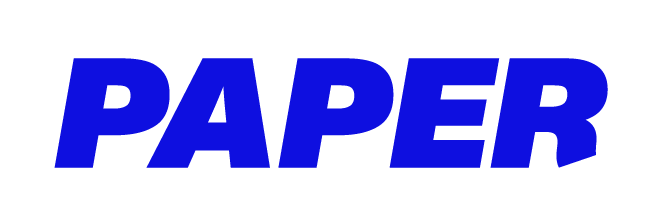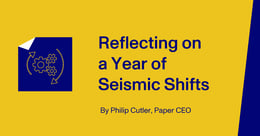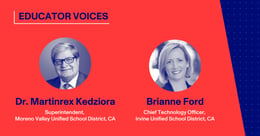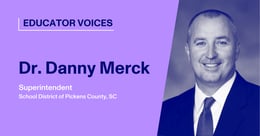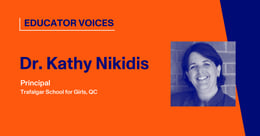
Changing the Where, When & How of Instruction
Paper’s Restart & Reimagine Discussion Series continued on November 18th, 4pm EST. Moderated by Natasha Mascarenhas, reporter at TechCrunch, school leaders from 4 states across the U.S. shared how they are reinventing and scaling instructional delivery.
→ Watch the webinar recording now
Featured speakers included:
- Beth Gonzalez, Assistant Superintendent of Curriculum and Instruction,
Detroit Public Schools Community District (DPSCS), Michigan - Brian Kingsley, Chief Academic Officer,
Charlotte-Mecklenburg Schools (CMS), North Carolina - Dr. Don Haddad, Superintendent,
St. Vrain Valley Schools (SVVS), Colorado - Janise Lane, Executive Director of Teaching and Learning,
Baltimore City Public Schools (BCPS), Maryland
As the reopening push and pull continues, school leaders are doubling down on evolving their practices to meet the needs of their school communities by expanding where, when, and how learning happens.
1. Planning for intermittent closure
2. What should stay, what should go
3. Organizing hybrid learning
4. Reaching students from afar
5. Equity, beyond the digital divide
6. Connecting dots in the community
7. What's bringing you joy?
1. Planning for intermittent closure
Beth Gonzalez, DPS:
As we conceptualized what this school year could be like, we understood that we might face intermittent closures. So our preparation for this started very early on as we approached our work for the school year.
As we launched professional learning for the fall, we said to educators, whether you’re face-to-face or online, it’s important that you become fluent with the online platforms and instructional materials that we’re providing for online students.
We actually encourage the use of these tools in our face-to-face settings both for social distancing and also the technology benefits that we’re seeing from the platforms themselves; teachers can see students’ real time work without hovering over their shoulders.
And then we’re supporting families through parent academies, we’re setting up regional hubs where people can come in person for support, and we stood up an online regional help hotline. We’re digging deep as we approach our second semester to think about what else we can do for teachers and families.
Janise Lane, BCPS:
On Monday, we brought back 25 schools, and those 25 schools are also, like Beth said, iterating on what reopening looks like. We too had a comprehensive plan in the beginning around how we could be all virtual, then hybrid and then back to virtual. So the curriculum is sound and ready for that.
Now it’s about ensuring that families and students are comfortable with the protocols. I never thought you could see a smile, under a mask, but you really can.
So when you see pictures of students or are at the school and watch students walk in, even though they’re six feet away from their peers, to be able to be there and hear the stories, we know that it’s the right thing that we have to do.
We’re pretty excited that in these 25 schools the leadership teams and teachers are really embracing studying what all this looks like. We have some schools that are doing a blended model where they are teaching half their kids in the classroom and half of them virtually, or some where they’ve decided that one teacher stays virtual and another is doing a small group face to face. And in Baltimore any family that is compromised or wants to stay online can do that as well.
It’s really allowing us to study the learning that’s happening across these 25 schools, so as we gradually bring more schools into this process to bring more students back, we can provide more options and choices for schools to make decisions, meet their goals, and make sure students and families are happy, safe and engaged.
2. What should stay, what should go
Brian Kingsley, CMS:
For our district, it was really important to focus on using this as an opportunity to reinvent our core business. So regardless of our decisions they continue to live across all modalities of learning, whether it’s flexible, remote and/or in person, we believe as a community that our model of schooling is going to stay in this space post-pandemic. We’re gonna have more families that continue to choose a remote option for their students.
And it’s really important that there’s consistency across all avenues: It’s not just thinking about access to devices and internet, but also how our content shows up.
We have made significantly sound curriculum adoptions in Charlotte over the last three to five years and we’re really proud of that but they weren’t all designed to show up the same way in a digital environment. So we’ve had to really double down with our thought partners and digital advisors as well as internally.
And we’re no longer constrained by the physical environment—how many teachers or curriculum specialists we can fit in a room.
We now have teachers collaborating across schools, redefining how curriculum shows up in their classrooms, and creating a standard of excellence in a digital environment. We were doing that in pockets before. I’m really excited about that.
3. Organizing hybrid schooling
Dr. Don Haddad, SVVS:
We did online learning for the first six weeks, and then we were able to transition into a hybrid model. We were fortunate in that we had a 1:1 initiative, all of our students had iPads from the onset, we had built out our bandwidth to have all teachers and students online at the same time without exhausting the bandwidth. So the infrastructure and PD was there.
Most recently Colorado and our county moved to another level of severity where COVID is concerned, so we are looking at perhaps shifting back—and we’ll make that decision tonight—to the fully online model in the hopes that in a few weeks it will begin to come back down so that we can get kids back in person.
The one thing I would emphasize is that the curriculum and instruction is important, and there’s also the connections that teachers are able to make with kids, or that they are not able to make with the distance between them in the online reality.
So it’s really important that while online can create some opportunities, we just have to make sure we never lose sight of the fact that the teacher is the critical component in the classroom with the student.
4. Reaching students from afar
Dr. Don Haddad, SVVS:
I think we’ve asked parents, and they have been great with working with their children at home to help facilitate and keep them focused as best they can. We also try to differentiate and personalize the learning.
There’s opportunities for students to create a video or keep a diary or a regular paragraph, or just the standard “answer these fifteen questions,”—all so kids feel like this is the kind of work they want to do, so it becomes engaging.
I think it’s also important to plan for breaks in the process. So the teacher might come on and do twenty or thirty minutes of instruction and then the students will have some of that time to do whatever they’re working on and break off into smaller groups, both virtually and in-person. So the connections that they’re able to make with their peers is really really important.
Beth Gonzalez, DPSCS:
One of the things that we have observed is that even in an online setting, much like when students were in person, they feel most engaged when they’re led through high quality and engaging instruction by their actual teacher. So as we approach this, a huge emphasis was placed on ensuring the high quality instructional materials and the rich and diverse texts that our teachers had already selected for our students continued to be used.
A lot of best practice about online learning is actually rooted in post-secondary students who are online, not K-12. So what we understood was that our teachers connecting with and engaging with their students live with their classmates was a really important part of our daily schedule.
And another strategy we pursued was offering enrichment activities and after-school clubs that we offer in person. So huge work was done so that chess clubs and robotics could be online and academic gains could take place. We’re still pursuing the spelling bee, and so while there continues to be a conversation about screen time, because unfortunately online is online, I will say that we are finding ways and places for students to connect with their peers and their academics and interests.
Brian Kingsley, CMS:
We have to acknowledge that we had gaps that existed before the pandemic. This is an opportunity to redefine how we are accountable to the most marginalized members of our community that experienced oppression, disconnect and lack of opportunity and access even in our traditional brick and mortar model.
I think that level of outreach and elevating their voice at the student, parents, faith-based community and governance level, and drawing upon them in partnership is really important. One thing that we found to be really successful is having bi-weekly community partner meetings. It started off with a mighty handful of organizations that were either non-profit or in the faith-based sector and we now have 350 people participating in those meetings, which has helped us as a system drive coherence around access points for students to have safe places to learn.
5. Equity, beyond the digital divide
Brian Kingsley, CMS:
I don't think we can unbraid racialized equity work from core instruction.
As we think about the way that instruction shows up, whether you're in a brick and mortar model or in a remote hybrid model—how we're thinking about our biases, expectations, mindsets, and our beliefs around what people can do, how they show up in the work, and how we show up in the work matters. We’re taking advantage of opportunities both to have community conversations, and we’re leveraging our professional development for teachers and principals.
We need to provide different types of support based on what people are asking for and what they’re experiencing—not just what we assume what they know and need.
We haven’t figured out all of it yet, we have more students struggling now than we’ve had in years past. And thinking back to the last ten years we’ve raised expectations for teachers and students without being holistic state-to-state to resource that problem. We’ve been taking bandaid approaches to curriculum, PD, and in some instances when economic conditions improve, we begin chasing technology solutions in isolation without really thinking about how when we change one aspect of that work, we’ve got to really change all aspects in conjunction.
Just focusing on human relationships isn’t enough to get students to graduate with options. So really being able to identify the sweet spot of building the community’s enthusiasm around high-quality content, significantly investing in teacher knowledge and skill, and redefining the way that students are engaging in learning—all of those things have to work together.
[Learn why school districts across the U.S. are partnering with Paper here.]
6. Connecting dots in the community
Janise Lane, BCPS:
I think my colleagues have covered much of the same story as in Baltimore, and I would only add the parent piece to that. So before, parents thought their job was to take kids to school, pick them up, make sure they do their homework. Whereas now, they’re really getting an insight into what the learning looks like, and invested into what their students are doing. We’re starting to offer a lot more opportunities like family academies. We’re taking a ton of feedback from surveys, focus groups and listening to parents to see how we can bridge gaps.
We want to make sure that families are part of this work as we move forward. We’ve said that for years but I don’t think it’s been a reality till now.
Beth Gonzalez, DPSCS:
We are hearing from our early grade teachers that they’re feeling even more connecting with their families, because they’re part of the classroom in some ways when students are online.
So we are already thinking forward to next fall, and what implications this work has for how we organize school and what things make parents even come to expect or demand from us now that they've had the opportunity to be part of the classroom in some ways.
We had a 23 million dollar investment that allowed us to provide tablets and internet access to our families and we feel really proud of that and it hasn’t actually been perfect. I’ve spent a lot of time talking about points of pride but I really want to be clear that this has been difficult. It’s been hard on us but it’s been harder on the families for whom that day, their tablet isn’t working and their child is missing out on learning.
7. What's bringing you joy?
Janise Lane, BCPS:
I think that something that’s given joy is seeing the tenacity that all parties have had in figuring all this out: students, teachers, parents, and our staff.
One thing that I’m proud of is the lens that Baltimore is taking around studying what we’re doing, and continuing to learn before saying, “this is the way it has to be."
Brian Kingsley, CMS:
I’m witnessing day after day that we’re building our collective self esteem of how important we are to progress, to our community and to our economy.
We’ve continued to figure out a way to use this disruption to make progress, and we’re doing this by leaning on each other.
And we’re all serving children in a more significant and impactful way because of that. It’s really inspiring.
Dr. Don Haddad, SVVS:
The outreach from our students to our teachers.
They’ve always been well-connected, but I think there’s a new sense of appreciation and understanding just how deeply our teachers care about our students and vice versa.
Another thing I’ve seen is how everybody in the school system has understood how important everyone’s roles are.
Beth Gonzalez, DPSCS:
A lot of the decisions have been: “What’s the best of the worst?” What’s been made clear during these hard times is that the people on my team making decisions are deep advocates for students. They’re thinking so critically about every decision we make and what the impacts are on health and safety, learning, and community needs beyond our own district. We’re providing tutoring services to students outside of our district because it’s actually the right thing to do.
I’m proud to be in a team that always thinks about students first.
Note: This recap has been edited for length and clarity.
